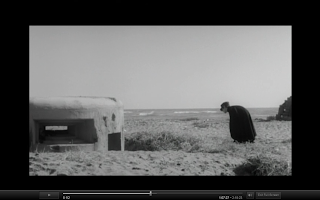In Fellini’s 8 ½ ,
a filmmaker struggles with writer’s block and the film becomes about the
creative process of filmmaking as well as the fantastical dream like memory
sequences interspersed throughout.
It is a self reflexive work that immediately makes apparent its own
awareness of its self reference within the opening scene, where Guido the
struggling director discusses the film as “a series of completely senseless episodes.”
What is most striking about this classic is the dramatic lighting, carefully
composed shots, and the fluidity of the editing between the “present” plot and
the memory sequences.
There is dramatic
high contrast present throughout most of the shots. The opening scene is a particularly vivid example of this—the
cars in the foreground are very dark and defined while the cars further away
are ghostly, pale, and misty.
Fellini maintains
a formal balance in his shots; there is a balance of dark blacks and light
whites, as well as a balance of negative space to positive space, and near/far
away. For example, often a figure
will be dressed in dark garments against a light background, increasing the
drama. Similarly, a figure against
a black background will be shown in a lighter color. For instance, in the dancing scene depicted below, the
figures a very dark against the ground.
There is a dynamic
tension between the use of shadow and light that is perhaps most prominent in
the depictions of peoples’ faces.
The actors’ faces are frequently reduced to a few large painterly
shadows, that are simple yet distinct enough to be instantly readable. Frequently a character will enter a
dark room and the camera shows there face moving in and out of shadows and
slivers of light.
The fluidity
between settings is impressively effortless. The scenes depicting episodes from Guido’s memories of
childhood or dreams feel natural albeit surreal. The transitions between vastly different settings go
unnoticed. For example, in one
scene there is a strange meeting with the cardinal in the woods and a moment
later there is a dancer on the beach singing. Each scene has a completely differently tone—the only thing
tying them together is perhaps their strangeness—and yet they fit together
without question. The film’s
ability to capture memory calls to mind Dorskys’s thoughts on cinema as a
particularly magical medium in that unlike other media, it has the unique
ability to very nearly replicate our experience of vision and therefore it functions
as a direct model for our being.
Fellini’s daydream sequences also speak to Dorsky’s suggestion that “We
don’t experience a solid continuum of existence.” Dorsky argues that life is full of gaps—spaces in which our
mental imagery overrides the imagery that actually appears before our
eyes. Fellini’s montages
illustrate this phenomenon very vividly.
Dorsky also writes of cuts being like dream connectives or shifts in
space, having an eerie and poetic quality to them. He argues that a good cut will arouse a certain response: “how
unexplainable, how poignant, how disarming.” This is perhaps the best way to characterize Fellini’s use
of the camera in 8 1/2.






No comments:
Post a Comment